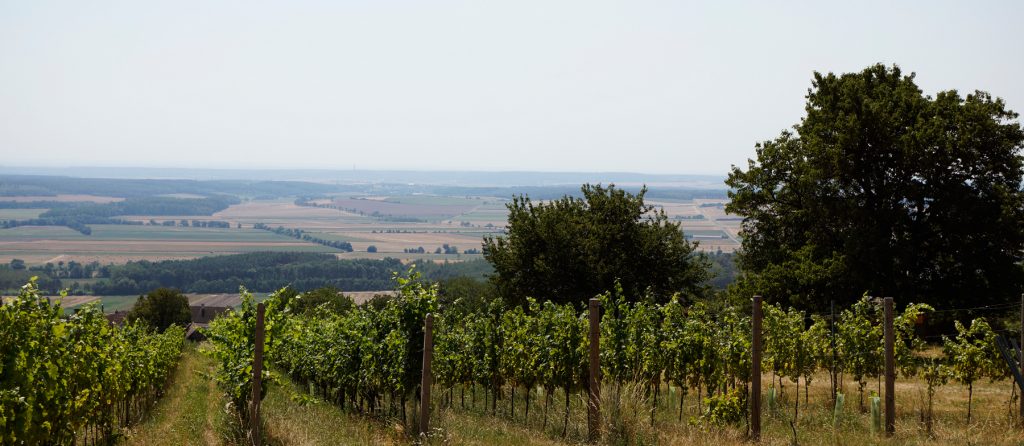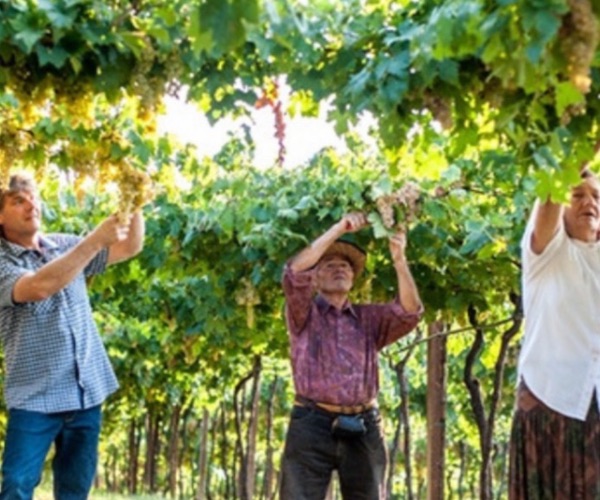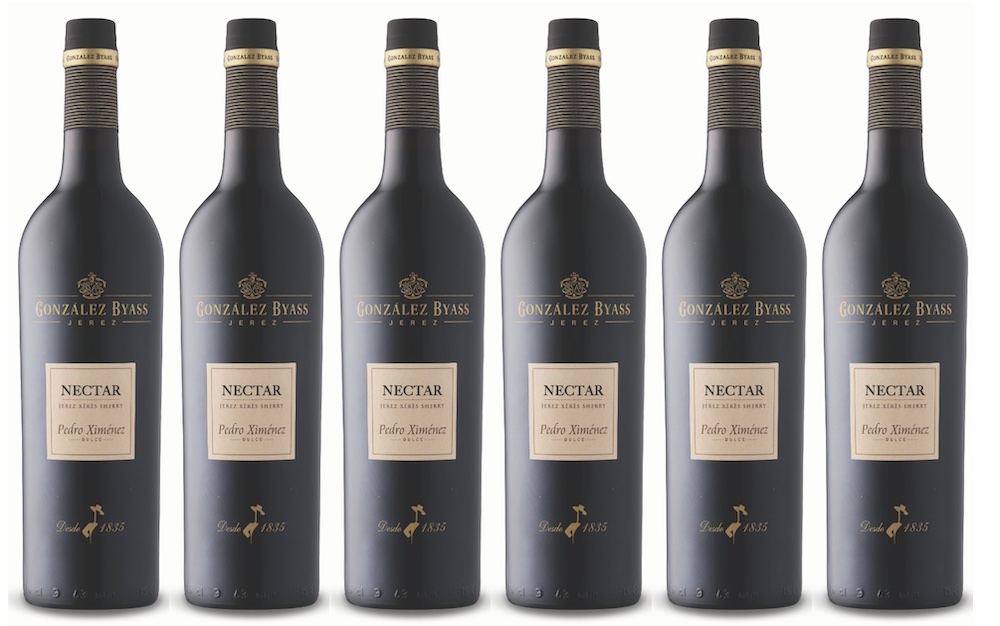
Looking out over the steeply sloping hills of Eisenberg in South Burgenland/Südburgenland, glass of extremely local Blaufränkish at the ready.
It is oft said that good things come in small packages, and this is most certainly the case when it comes to Eisenberg in the southeast corner of Austria; with merely 500 hectares of vineyards, Eisenberg counts itself as the very smallest wine region in the country.
Referred to as Südburgenland between the years of 1986 and 2009, the old name of Eisenberg was reintroduced in 2010, a term that had historically implied that wines from this designation were of a most notable quality. Upon travelling to this tiny region only last week, I was quite taken aback by the area’s natural unspoiled beauty, its idyllic remoteness, and the marked individuality of its truly incomparable wines.
Historically Eisenberg is rather fascinating, for indeed it was the Celts who originally cultivated vines upon these slopes long before the Romans arrived upon the scene; fossils of vitis vinifera grape seeds found at Celtic burial pits dating back the to 8th Century BC have been discovered within the region.
Throughout the Middle Ages Eisenberg was widely admired as a source of superior wines, with most of the better sites being owned by the nobility or the church, and records showing that even Burgundy’s Cisterian monks possessed properties throughout the region.
What with this land mass being nestled so close to neighbouring Hungary, it should come as no surprise to learn that much of Südburgenland has been under that country’s rule for much of its history. From the 14th Century onwards the entire county of Eisenberg was under Hungarian administration. Throughout both the Hapsburg (1526 – 1804) and Austro-Hungarian (1867 – 1918) monarchies the mainly German-speaking region was considered to be part of what was referred to as the Transleithan (read: Hungarian) empire.
After the First World War it was decided that territories in the Western part of Hungary, still populated by mostly German speakers, would be ceded to Austria, a decision that the Hungarians were less than happy with due to the region’s economic value. After much back and forth over the years, Burgenland was finally integrated into the Republic of Austria in 1921, but the Hungarian influence over the region’s viticultural history can be felt to this very day.
After the reconstruction initiated at the end of the Second World War most of the vineyards of the region were reconfigured, with the Burgundian-like inheritance laws regarding family vineyard ownership being abandoned in favour of rulings allowing the establishment of larger wineries. Parallel to this was the almost universal reconfiguration of vineyards from the traditional single vine training method to the Hochkultur or High Culture system, thus allowing for mechanical harvesting.
Despite all of this revitalisation, it took the region some significant time to come into its own in the modern wine world. Hampered by 1985’s notorious Austrian wine scandal, the global fashion for soft, easy drinking red blends, a shrinking populace due to rural flight, and the region’s isolation from the rest of the country, it wasn’t really until the mid 2000s, thanks to the determination of those who steadfastly believed in the region’s true potential, that the unique wines of Eisenberg really hit their stride, and the world began to take notice.
Although the mighty Blaufränkisch is today the predominant varietal in the region (all wines bearing the DAC are 100% Blaufränkisch) it is thought that it wasn’t until after the phylloxera infestations of the late 19th Century, when many vineyards were ripped out or abandoned, that the grape was brought to Burgenland. Previous to this the area was mainly known for its white wines derived from the Furmint varietal.
Upon evaluating the wines of Eisenberg I was immediately struck by the acidically structured, elegantly tannic, herbaceously spicy, mineral driven, and seriously terroir focused nature of 99% of the bottles I tasted. This had me wondering what the common factor was; what gave these wines such defined personality across the board?
The answer, I feel, comes from a number of very specific climatic conditions in combination with a complex tapestry of geological factors and soil types, 99% of the time those being of a ferruginous nature (read: rich in iron oxides).
Being located between Hungary (to the east) and Styria (to the west), Eisenberg is considered a transition zone both topographically and geographically. Perched right on the Hungarian border, the region has had a historied and tumultuous geological past, consequently leading to the veritable patchwork of diverse rock formations found throughout this relatively diminutive area.
Climatically Eisenberg falls under the Pannonian-Illyrian descriptor, meaning the region enjoys long and hot summer months but with adequately sufficient rainfall for grape growing. This is coupled with Mediterranean air currents from the south east meaning the area is blessed with cool enough nights to allow for the complete aromatic and flavour development of the grapes, and therein lies a little of the Eisenberg Blaufränkisch magic.
Grape growing in the region can unequivocally be described as mountain viticulture, although the deceptively mountainous nature of the landscape is not immediately apparent to the casual visitor… it took me a little while to realise myself. In reality, the larger part of Eisenberg’s vineyards are located between 280 and 400m above sea level, with some vineyards planted at 480m above sea level.
And then we come to the unique soils of Südburgenland, which are without any shadow of a doubt (for me anyway!) the dominative influence upon the profiles of the Blaufränkisch wines of the Eisenberg. The vines of the region are planted upon what is predominantly Mesozoic and Palaeozoic era greenschist covered by a thick layer of loam and/or clay that in almost all cases contains concentrations of iron. Of course, when I say iron, I’m referring here to iron oxides, as iron, despite being the fourth most abundant element in the earth’s crust, is very rarely found in its pure state, and more often present in bound form. In alkaline soils, such as those in Eisenberg, one will find iron in its oxidised forms, and in acidic soils it will be salinised as ferrous sulphate.
Although officially the jury is still out as to exactly how soil composition and mineral distribution impacts the aromatic/flavour/structural profile of wines, I think that the unique mineral-rich soils of Eisenberg give the region’s wines a truly distinctive cool-mineral, fruit, spicy character that I have tasted nowhere else in this world.

Edinburgh-born/Toronto-based Sommelier, consultant, writer, judge, and educator Jamie Drummond is the Director of Programs/Editor of Good Food Revolution… And that region was a real eye-opener. Terrific wines.









